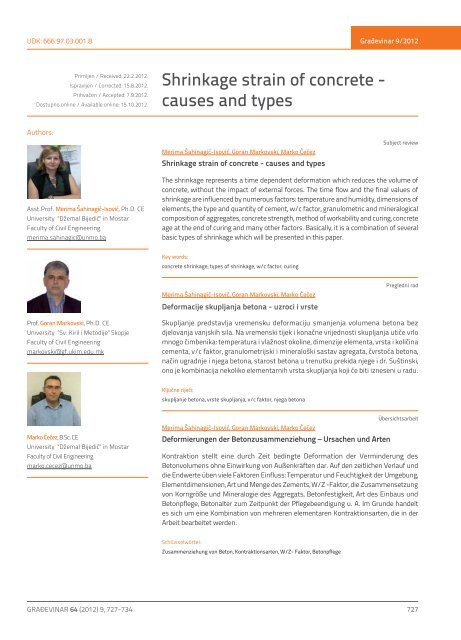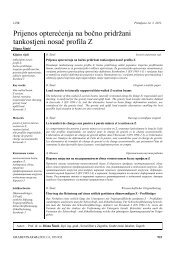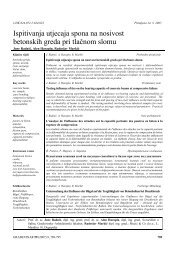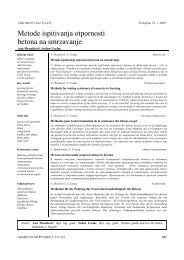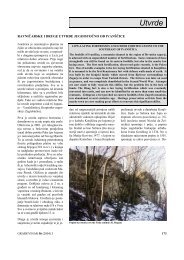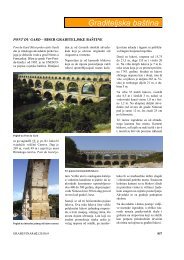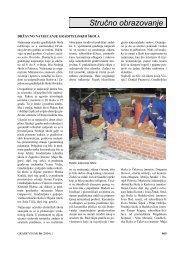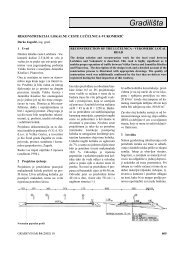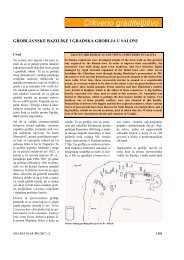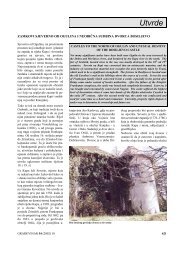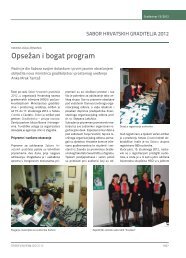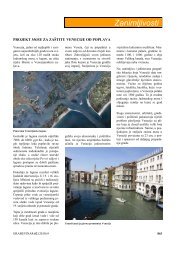Shrinkage strain of concrete - causes and types - Građevinar
Shrinkage strain of concrete - causes and types - Građevinar
Shrinkage strain of concrete - causes and types - Građevinar
Create successful ePaper yourself
Turn your PDF publications into a flip-book with our unique Google optimized e-Paper software.
UDK: 666.97.03.001.8<br />
Primljen / Received: 22.2.2012.<br />
Ispravljen / Corrected: 15.8.2012.<br />
Prihvaćen / Accepted: 7.9.2012.<br />
Dostupno online / Available online: 15.10.2012.<br />
Authors:<br />
Asst.Pr<strong>of</strong>. Merima Šahinagić-Isović, Ph.D. CE<br />
University "Džemal Bijedić" in Mostar<br />
Faculty <strong>of</strong> Civil Engineering<br />
merima.sahinagic@unmo.ba<br />
Pr<strong>of</strong>. Goran Markovski, Ph.D. CE<br />
University "Sv. Kiril i Metodije" Skopje<br />
Faculty <strong>of</strong> Civil Engineering<br />
markovski@gf.ukim.edu.mk<br />
Marko Ćećez, B.Sc. CE<br />
University "Džemal Bijedić" in Mostar<br />
Faculty <strong>of</strong> Civil Engineering<br />
marko.cecez@unmo.ba<br />
GRAĐEVINAR 64 (2012) 9, 727-734<br />
<strong>Shrinkage</strong> <strong>strain</strong> <strong>of</strong> <strong>concrete</strong> -<br />
<strong>causes</strong> <strong>and</strong> <strong>types</strong><br />
Merima Šahinagić-Isović, Goran Markovski, Marko Ćećez<br />
<strong>Shrinkage</strong> <strong>strain</strong> <strong>of</strong> <strong>concrete</strong> - <strong>causes</strong> <strong>and</strong> <strong>types</strong><br />
<strong>Građevinar</strong> 9/2012<br />
Subject review<br />
The shrinkage represents a time dependent deformation which reduces the volume <strong>of</strong><br />
<strong>concrete</strong>, without the impact <strong>of</strong> external forces. The time flow <strong>and</strong> the final values <strong>of</strong><br />
shrinkage are influenced by numerous factors: temperature <strong>and</strong> humidity, dimensions <strong>of</strong><br />
elements, the type <strong>and</strong> quantity <strong>of</strong> cement, w/c factor, granulometric <strong>and</strong> mineralogical<br />
composition <strong>of</strong> aggregates, <strong>concrete</strong> strength, method <strong>of</strong> workability <strong>and</strong> curing, <strong>concrete</strong><br />
age at the end <strong>of</strong> curing <strong>and</strong> many other factors. Basically, it is a combination <strong>of</strong> several<br />
basic <strong>types</strong> <strong>of</strong> shrinkage which will be presented in this paper.<br />
Key words:<br />
<strong>concrete</strong> shrinkage, <strong>types</strong> <strong>of</strong> shrinkage, w/c factor, curing<br />
Merima Šahinagić-Isović, Goran Markovski, Marko Ćećez<br />
Deformacije skupljanja betona - uzroci i vrste<br />
Pregledni rad<br />
Skupljanje predstavlja vremensku deformaciju smanjenja volumena betona bez<br />
djelovanja vanjskih sila. Na vremenski tijek i konačne vrijednosti skupljanja utiče vrlo<br />
mnogo čimbenika: temperatura i vlažnost okoline, dimenzije elementa, vrsta i količina<br />
cementa, v/c faktor, granulometrijski i mineraloški sastav agregata, čvrstoća betona,<br />
način ugradnje i njega betona, starost betona u trenutku prekida njege i dr. Suštinski,<br />
ono je kombinacija nekoliko elementarnih vrsta skupljanja koji će biti izneseni u radu.<br />
Ključne riječi:<br />
skupljanje betona, vrste skupljanja, v/c faktor, njega betona<br />
Übersichtsarbeit<br />
Merima Šahinagić-Isović, Goran Markovski, Marko Ćećez<br />
Deformierungen der Betonzusammenziehung – Ursachen und Arten<br />
Kontraktion stellt eine durch Zeit bedingte Deformation der Verminderung des<br />
Betonvolumens ohne Einwirkung von Außenkräften dar. Auf den zeitlichen Verlauf und<br />
die Endwerte üben viele Faktoren Einfluss: Temperatur und Feuchtigkeit der Umgebung,<br />
Elementdimensionen, Art und Menge des Zements, W/Z -Faktor, die Zusammensetzung<br />
von Korngröße und Mineralogie des Aggregats, Betonfestigkeit, Art des Einbaus und<br />
Betonpflege, Betonalter zum Zeitpunkt der Pflegebeendigung u. A. Im Grunde h<strong>and</strong>elt<br />
es sich um eine Kombination von mehreren elementaren Kontraktionsarten, die in der<br />
Arbeit bearbeitet werden.<br />
Schlüsselwörter:<br />
Zusammenziehung von Beton, Kontraktionsarten, W/Z- Faktor, Betonpflege<br />
727
<strong>Građevinar</strong> 9/2012<br />
1. Introduction<br />
During the hardening process <strong>of</strong> <strong>concrete</strong> due to the effects <strong>of</strong><br />
cement hydration <strong>and</strong> <strong>concrete</strong> drying process due to water<br />
loss, there is a reduction <strong>of</strong> the <strong>concrete</strong> volume. Concrete<br />
shrinkage is a characteristic where the <strong>concrete</strong> changes<br />
its volume over time in a way that it decreases dimensions<br />
<strong>of</strong> unloaded <strong>concrete</strong> constructions proportionally in all<br />
directions. As porous hard material, <strong>concrete</strong> starts deforming<br />
as soon as it is exposed to mechanical, thermal or hydrologic<br />
effects. Therefore, when it comes to origin <strong>of</strong> <strong>concrete</strong><br />
shrinkage we can talk about its three aspects: chemical,<br />
thermal <strong>and</strong> hydrologic processes [1].<br />
Hydrological effects, as well as thermal effects, are the result<br />
<strong>of</strong> environmental conditions changes or changes in the<br />
<strong>concrete</strong> mass. Under the environmental conditions change<br />
we consider the changes <strong>of</strong> temperature <strong>and</strong> humidity. Under<br />
the changes within the <strong>concrete</strong> mass we are considering:<br />
heat produced by cement hydration <strong>and</strong> self-desiccation [2,<br />
3], which is result <strong>of</strong> hydration continuation after <strong>concrete</strong><br />
binding, ie reduction in relative humidity due to the hydration<br />
process [2]. As a consequence, all these changes suffer<br />
from decrease in temperature <strong>and</strong> hydraulic potential <strong>of</strong><br />
construction i.e. they cause a loss <strong>of</strong> equilibrium conditions<br />
with environment. Therefore, <strong>strain</strong>s that occur are never<br />
uniform. They cause constructive effects <strong>and</strong> stresses.<br />
2. Required material properties for defining<br />
shrinkage<br />
In order to underst<strong>and</strong>, analyze <strong>and</strong> quantify all these effects<br />
on <strong>concrete</strong> shrinkage we need information regarding the<br />
following four elements:<br />
- mechanical effect <strong>of</strong> temperature changes;<br />
- thermal effect <strong>of</strong> cement hydration;<br />
- hydrological effect when it comes to hydration;<br />
- hydrological effect when it comes to climate [1].<br />
To define mechanical effect <strong>of</strong> temperature changes we<br />
need to determine the value <strong>of</strong> temperature change over<br />
time as well as the change <strong>of</strong> - <strong>concrete</strong> elasticity module<br />
<strong>and</strong> coefficient <strong>of</strong> thermal expansion (CTE). For mentioned<br />
parameters, we need to determine laws <strong>of</strong> their change over<br />
time.<br />
Concrete elasticity module is deformation <strong>of</strong> <strong>concrete</strong> under<br />
short-term load. Elasticity module develops significantly<br />
during the hardening, as well as mechanical strength, same<br />
as the compressive strength, we can consider module as<br />
monotonous continual increasing function <strong>of</strong> <strong>concrete</strong> age.<br />
Choice <strong>of</strong> aggregate has the biggest effect on elasticity<br />
module. Primarily, due to a larger share <strong>of</strong> aggregate (70 - 80<br />
%) in the whole composite mass compared to cement paste<br />
share, secondly because, in general, there is less room to<br />
change parameters that are changing module with aggregates<br />
Merima Šahinagić-Isović, Goran Markovski, Marko Ćećez<br />
than that are changing with cement mass. This second reason<br />
is closely connected to the aggregate effect on mechanical<br />
composite strength.<br />
Similar to elasticity module, coefficient <strong>of</strong> thermal expansion<br />
(CTE) depends more on aggregate than on cement paste due to<br />
volume relations. Coefficient <strong>of</strong> thermal expansion <strong>of</strong> cement<br />
paste varies from 11x10 -6 to 20x10 -6 1/°C, which depends <strong>of</strong><br />
humidity, while coefficient <strong>of</strong> thermal expansion <strong>of</strong> aggregates<br />
varies from 1x10 -6 to 14x10 -6 1/°C, which depends <strong>of</strong> type <strong>of</strong><br />
rock. Coefficient <strong>of</strong> thermal expansion values for <strong>concrete</strong> varies<br />
from 6 or 7x10 -6 1/°C for <strong>concrete</strong> with lime aggregate to 12 or<br />
13x10 -6 1/°C for <strong>concrete</strong>s with silica aggregate. With sufficient<br />
accuracy in practice, we mostly adopt value <strong>of</strong> coefficient <strong>of</strong><br />
thermal expansion for <strong>concrete</strong> from 10x10 -6 1/°C. In the other<br />
h<strong>and</strong>, opposite to E-module, coefficient <strong>of</strong> thermal expansion is<br />
practically constant after the first few hours <strong>of</strong> binding. Coefficient<br />
<strong>of</strong> thermal expansion has important part in elements which are<br />
exposed to prevented <strong>strain</strong>s conditions, in cases <strong>of</strong> massive<br />
constructions (for example, dams) or in cases <strong>of</strong> elements exposed<br />
to great changes <strong>of</strong> temperature (for example, pavements).<br />
To describe the thermal effects <strong>of</strong> cement hydration is<br />
necessary to determine the above mentioned parameters<br />
<strong>and</strong> the law that describes the development <strong>of</strong> heat during<br />
hydration. The hydration heat <strong>of</strong> cement is the amount <strong>of</strong> heat<br />
per gram <strong>of</strong> non-hydrated cement, which is released during<br />
the hydration process. It depends on chemical composition<br />
<strong>of</strong> cement (it grows with the amount <strong>of</strong> C 3 A) <strong>and</strong> grinding<br />
fineness. Hydration cement heat is an important feature<br />
in massive constructive elements (for example, dams,<br />
foundation blocks) but also when the elements are exposed<br />
to prevented ultimate <strong>strain</strong>s conditions (for example,<br />
pavements, <strong>concrete</strong> plates, composite structures), i.e. in<br />
medium thick constructions (smaller than 20 cm), when the<br />
one side is thermally isolated. With these two construction<br />
<strong>types</strong>, influence <strong>of</strong> thermal shrinkage is in superimposes<br />
with its autogenous shrinkage. Due to hydration, because<br />
<strong>of</strong> heat release, first occurs thermal expansion <strong>of</strong> <strong>concrete</strong>,<br />
which led to the cooling process <strong>of</strong> <strong>concrete</strong>, which represents<br />
the thermal shrinkage. Concrete with high hydration heat<br />
<strong>of</strong>ten have great autogenous shrinkage like in a case <strong>of</strong> high<br />
strength <strong>concrete</strong>.<br />
For hydrological effects related to hydration we need to<br />
establish the law <strong>of</strong> shrinkage development, which is<br />
determined in absence <strong>of</strong> any kind <strong>of</strong> hydrologic change with<br />
environment. These effects result in autogenous shrinkage<br />
which is consistent. If we observe it from a specific scale, the<br />
scale where <strong>concrete</strong> as granular material can be considered<br />
as homogeneous, it represents quintuple value from the<br />
biggest aggregate grain [1]. Therefore, autogenous shrinkage<br />
is internal characteristic <strong>of</strong> material <strong>and</strong> it is independent<br />
from the specimen size.<br />
For hydrological effects related to climate we need to establish<br />
the law <strong>of</strong> shrinkage development due to environmental<br />
728 GRAĐEVINAR 64 (2012) 9, 727-734
<strong>Shrinkage</strong> <strong>strain</strong> <strong>of</strong> <strong>concrete</strong> - <strong>causes</strong> <strong>and</strong> <strong>types</strong><br />
conditions, which constitute a natural drying. Under<br />
environmental conditions implies temperature <strong>and</strong> humidity.<br />
In addition, this law must be an indication <strong>of</strong> the quantitative<br />
element dimensions characteristics <strong>of</strong> which depends the<br />
dynamics <strong>of</strong> drying. These effects give drying shrinking which<br />
depends on the size <strong>of</strong> the element, <strong>and</strong> therefore is not<br />
internal material characteristics.<br />
3. <strong>Shrinkage</strong> <strong>types</strong><br />
According to authors from the region, traditional classification<br />
<strong>of</strong> <strong>concrete</strong> shrinkage was according to [4]:<br />
- shrinkage due to water evaporation during the cement<br />
binding process (plastic shrinkage);<br />
- shrinkage due to contraction <strong>of</strong> the hydration products<br />
(hydration shrinkage);<br />
- shrinkage after cement binding process is complete (hardened<br />
<strong>concrete</strong> shrinkage due to drying or hydraulic shrinkage);<br />
while according to [5] it is:<br />
- autogenous shrinkage;<br />
- plastic shrinkage;<br />
- hardened <strong>concrete</strong> drying shrinkage;<br />
- carbonation shrinkage.<br />
But shrinking is rather complex phenomenon that depends<br />
on numerous factors <strong>and</strong> represents combination <strong>of</strong> several<br />
elementary forms <strong>of</strong> shrinkage:<br />
- plastic shrinkage, which develops on the surface <strong>of</strong> fresh<br />
<strong>concrete</strong> exposed to drying;<br />
- chemical shrinkage, which is consequence <strong>of</strong> chemical<br />
binding i.e. using <strong>of</strong> water in <strong>concrete</strong> in the cement<br />
hydration process;<br />
- autogenous shrinkage, some called it hydration shrinkage,<br />
it is closely connected to chemical shrinkage, <strong>and</strong> it is a<br />
consequence <strong>of</strong> self-desiccation in pores <strong>of</strong> cement paste<br />
in the process <strong>of</strong> hydration <strong>of</strong> non hydrated cement;<br />
- drying shrinkage, when the <strong>concrete</strong> is exposed to<br />
environment what <strong>causes</strong> evaporation water from capillaries;<br />
- thermal shrinkage, which is result <strong>of</strong> temperature changes<br />
in <strong>concrete</strong> in the process <strong>of</strong> hydration;<br />
- carbonation shrinkage, where carbon dioxide from the<br />
environment <strong>causes</strong> chemical reactions in cement stone.<br />
Cause <strong>of</strong> all this shrinkage <strong>types</strong> is loss i.e. use <strong>of</strong> water in <strong>concrete</strong>,<br />
except in the case <strong>of</strong> carbonation shrinkage, which is a consequence<br />
<strong>of</strong> hydrated cement paste reaction with carbon dioxide from the<br />
environment in humidity conditions. Water can either exit from<br />
<strong>concrete</strong> to environment or it can be used in cement hydration.<br />
Therefore the size <strong>and</strong> the grade <strong>of</strong> <strong>concrete</strong> shrinkage depend on<br />
water cement ratio <strong>of</strong> <strong>concrete</strong> mixture, that is, they depend on<br />
<strong>concrete</strong> strength. Total shrinkage should be taken as the sum<br />
<strong>of</strong> each individual volume change due to carbonation, thermal<br />
change, drying <strong>and</strong> autogenous shrinkage [2].<br />
GRAĐEVINAR 64 (2012) 9, 727-734<br />
3.1. Plastic shrinkage<br />
<strong>Građevinar</strong> 9/2012<br />
Plastic shrinkage develops on the surface <strong>of</strong> the fresh<br />
<strong>concrete</strong> i.e. it is a consequence <strong>of</strong> water evaporation from<br />
the surface <strong>of</strong> fresh <strong>concrete</strong> or absorption in the <strong>concrete</strong><br />
form or bedding. Compared to other <strong>types</strong> <strong>of</strong> shrinkage it<br />
is the greatest <strong>and</strong> it size can be 1 % <strong>of</strong> its cement volume.<br />
It is developing very fast in the first several hours <strong>and</strong> as<br />
such mainly it is not registered. Typically, it is not significant<br />
compared to stress conditions <strong>of</strong> constructions because it<br />
occurs in the fluid mass <strong>of</strong> the fresh <strong>concrete</strong>. It occurs in<br />
the cases when due to evaporation <strong>of</strong> water mixture clots<br />
<strong>and</strong> pieces contained in fresh <strong>concrete</strong> are moving towards<br />
each other. Surface layer shrinkage is prevented in internal<br />
parts <strong>of</strong> <strong>concrete</strong> which do not shrink what leads to tensile<br />
stress in the surface layer. These stresses can be bigger from<br />
the tensile strength <strong>of</strong> young <strong>concrete</strong> what leads to plastic<br />
cracks, shallow <strong>and</strong> wide. Bigger quantities <strong>of</strong> cement increase<br />
the amount <strong>of</strong> plastic shrinkage. Damage effects <strong>of</strong> this type<br />
<strong>of</strong> shrinkage can be eliminated relatively easy by correct <strong>and</strong><br />
intensive <strong>concrete</strong> cure i.e. by wetting <strong>of</strong> <strong>concrete</strong> elements<br />
(or covering with membranes) with the purpose <strong>of</strong> retrieving<br />
water (or to prevent its evaporation).<br />
3.2. Chemical shrinkage<br />
Chemical shrinkage <strong>of</strong> cement paste represents decrease <strong>of</strong><br />
volume cement paste which occurs due to chemical binding <strong>of</strong><br />
water in the process <strong>of</strong> cement hydration.<br />
In the process <strong>of</strong> <strong>concrete</strong> hardening, several chemical<br />
transformations develop in the cement paste. The direct<br />
consequence <strong>of</strong> these chemical transformations is a decrease<br />
<strong>of</strong> cement paste volume. This phenomenon is clearly shown<br />
at the figure 1. Resulting volume <strong>of</strong> the hydration products,<br />
which is formed in the reaction <strong>of</strong> water <strong>and</strong> cement is<br />
smaller than volume <strong>of</strong> input components, cement <strong>and</strong> water<br />
together. The main reasons <strong>of</strong> cement paste volume decrease,<br />
if we compare it to volume <strong>of</strong> water <strong>and</strong> cement, are increased<br />
stiffness <strong>of</strong> chemically compounded water compared to free<br />
water <strong>of</strong> mixture before binding.<br />
Figure 1. Schematic description <strong>of</strong> chemical shrinkage mechanism [6]<br />
729
<strong>Građevinar</strong> 9/2012<br />
Internal forces which occur with development <strong>of</strong> microstructure<br />
by cement paste hardening cause certain <strong>strain</strong>s <strong>of</strong> cement<br />
paste i.e. <strong>concrete</strong>. At the certain stage <strong>of</strong> hardening process<br />
leads to shrinkage <strong>of</strong> cement paste causing additional<br />
empty pores contributing to increase the joint pore volume<br />
in the cement paste that hardens. Pores occurred due to<br />
chemical shrinkage have an important position in autogenous<br />
shrinkage [6].<br />
3.3. Autogenous shrinkage<br />
Autogenous shrinkage <strong>of</strong> <strong>concrete</strong>, which some also call<br />
hydration shrinkage is a result <strong>of</strong> self-desiccation process in<br />
the pores <strong>of</strong> cement stone, it is the use <strong>of</strong> water in the cement<br />
hydration processes [7]. Chemical <strong>and</strong> autogenous shrinkage<br />
are very bonded <strong>and</strong> it is hard to draw the line between these<br />
two <strong>types</strong> <strong>of</strong> shrinkage. Primarily, chemical shrinkage occurs<br />
<strong>and</strong> then we have additional pores due to hydration. Process <strong>of</strong><br />
self-desiccation begins in these pores because <strong>of</strong> the process<br />
<strong>of</strong> hydration i.e. inside the cement stone structure all water is<br />
used for hydration <strong>and</strong> humidity cannot reach fast enough from<br />
the outside due to density structure. This leads to shrinkage<br />
(even cracks inside the <strong>concrete</strong>) what we call autogenous<br />
shrinkage (Figure 2.). Most <strong>of</strong> the autogenous shrinkage is done<br />
in the first month i.e. in the first days <strong>and</strong> starts several hours<br />
after mixing what depends on the mixture type.<br />
Figure 2. Relations between autogenous <strong>and</strong> chemical shrinkage: C -<br />
unhydrated cement, W - unhydrated water, Hy - hydration<br />
products, <strong>and</strong> V - voids generated by hydration [3]<br />
Theoretically, level <strong>of</strong> autogenous shrinkage development<br />
is determined by the degree <strong>of</strong> cement hydration because<br />
most <strong>of</strong> the autogenous shrinkage occurs in the first month.<br />
Time development law <strong>of</strong> these <strong>strain</strong>s is directly connected<br />
to cement hydration dynamic, which on the other side,<br />
controls value development <strong>of</strong> mechanical <strong>concrete</strong> strength.<br />
Parameters that influence this dynamics are therefore the<br />
same who influence the increase <strong>of</strong> the strength value: type<br />
<strong>and</strong> fineness <strong>of</strong> cement grind <strong>and</strong> water cement ratio (w/c).<br />
Development curve <strong>of</strong> autogenous shrinkage therefore, is<br />
Merima Šahinagić-Isović, Goran Markovski, Marko Ćećez<br />
very well compatible with the development <strong>of</strong> mechanical<br />
strength curve. In the first several days, the development<br />
<strong>of</strong> autogenous shrinkage is very fast. It reaches from 60<br />
to 90 % <strong>of</strong> shrinkage value <strong>of</strong> 28 days. Total intensity <strong>of</strong><br />
autogenous shrinkage is moderate, but when we add it to<br />
other shrinkages we have non-insignificant values: from 100<br />
to 300x10 -6 . Rate <strong>of</strong> its development in the early stage is <strong>of</strong><br />
this kind, so this shrinkage was overlooked by the experts for<br />
a long time, because conventional shrinkage tests (at least<br />
those tests used for determination <strong>of</strong> the laws mentioned in<br />
the calculation rules) begin within 48 hours or 3 days.<br />
Autogenous shrinkage stays less than 10 -4 (figure 3.) for<br />
<strong>concrete</strong> where water cement ratio (w/c) is greater than 0,45<br />
but increases very fast when this ratio decrease below 0,40<br />
<strong>and</strong> can reach value <strong>of</strong> 3x10 -4 (figure 4.) [1].<br />
Figure 3. Autogenous shrinkage <strong>of</strong> the ordinary <strong>concrete</strong>s with<br />
different strengths [1]<br />
Figure 4. Autogenous shrinkage <strong>of</strong> the high strength <strong>concrete</strong> with<br />
different strengths ("*-" without silica dust) [1]<br />
Autogenous shrinkage measured with ordinary strength<br />
<strong>concrete</strong> with water cement ratio <strong>of</strong> 0,54 tested in TNO [8] was<br />
practically insignificantly low. This fact is probably the reason<br />
why in the past autogenous shrinkage did not have extra<br />
730 GRAĐEVINAR 64 (2012) 9, 727-734
<strong>Shrinkage</strong> <strong>strain</strong> <strong>of</strong> <strong>concrete</strong> - <strong>causes</strong> <strong>and</strong> <strong>types</strong><br />
attention when researching ordinary strength <strong>concrete</strong>, while<br />
with high strength <strong>concrete</strong> that have very low water cement<br />
ratio autogenous shrinkage represents an important part <strong>of</strong><br />
the total shrinkage process. Generally, autogenous shrinkage<br />
increases with the decrease <strong>of</strong> water cement ratio. Experiments<br />
results, which are obtained in France [9], showed that decrease<br />
<strong>of</strong> water cement ratio from 0,41 to 0,33 had caused increase <strong>of</strong><br />
autogenous shrinkage by 56 %. Therefore, autogenous shrinkage<br />
with high strength <strong>concrete</strong> is significantly greater than with<br />
ordinary strength <strong>concrete</strong>. Some researchers have concluded<br />
that this is 2 to 2,5 times bigger increase [10]. Autogenous<br />
shrinkage <strong>of</strong> ultra high performance <strong>concrete</strong> is even more<br />
expressive, while the drying shrinkage is very little [11]. And at<br />
the self-compacting <strong>concrete</strong> (SCC), due to the presence <strong>of</strong> large<br />
cement paste volume, autogenous shrinkage is very large [12].<br />
Similarly can be concluded from the results <strong>of</strong> own<br />
experimental tests [6] wherein mixtures <strong>of</strong> ordinary <strong>concrete</strong><br />
<strong>and</strong> high-strength <strong>concrete</strong> in the form <strong>of</strong> prisms dimensions<br />
10/10/40 cm <strong>and</strong> age <strong>of</strong> 420-430 days, were tested. Tested<br />
ordinary <strong>concrete</strong> had water-cement ratio w/c = 0,58, <strong>and</strong> the<br />
mean value <strong>of</strong> autogenous shrinkage 112x10 -6 , while the high<br />
strength <strong>concrete</strong>, had water-cement ratio w/c = 0,36, <strong>and</strong><br />
the mean value <strong>of</strong> autogenous shrinkage 264x10 -6 (Figure 5.).<br />
As a results showed autogenous shrinkage <strong>of</strong> high strength<br />
<strong>concrete</strong> is greater than autogenous shrinkage <strong>of</strong> ordinary<br />
<strong>concrete</strong> by about 2,3 times.<br />
Autogeneus shrinkage e as [10 -6 ] ms<br />
300<br />
250<br />
200<br />
150<br />
100<br />
50<br />
0<br />
0 40 80 120 160 200 240 280 320 360 400 440<br />
Time [days]<br />
Figure 5. Autogenous shrinkage <strong>of</strong> ordinary strength <strong>concrete</strong> (OSC)<br />
<strong>and</strong> high strength <strong>concrete</strong> (HSC)<br />
Autogenous shrinkage is increased with the increase <strong>of</strong> micro<br />
silica share. This is the result <strong>of</strong> fine hydrate cement paste<br />
micro structure. Having in mind the researches by Le Roy <strong>and</strong><br />
De Larrard [9], autogenous shrinkage <strong>of</strong> <strong>concrete</strong> is increasing<br />
by 40 % due to addition <strong>of</strong> 8 % <strong>of</strong> micro silica.<br />
3.4. Drying shrinkage<br />
Opposite to self-desiccation shrinkage (autogenous shrinkage),<br />
this type <strong>of</strong> shrinkage is reflected from the surface towards<br />
the interior <strong>of</strong> the <strong>concrete</strong> mass. Drying shrinkage refers<br />
to the reduction in <strong>concrete</strong> volume resulting from a loss <strong>of</strong><br />
water from the <strong>concrete</strong>. Initially, free water escapes to the<br />
GRAĐEVINAR 64 (2012) 9, 727-734<br />
<strong>Građevinar</strong> 9/2012<br />
<strong>concrete</strong> surface as bleed water. Once the bleed water has<br />
disappeared, excess water will be pulled from the interior <strong>of</strong><br />
the <strong>concrete</strong> mass [2]. Drying level varies according to the<br />
thickness <strong>of</strong> element, between its maximal value (on the<br />
surface) <strong>and</strong> its minimal value (in the core).<br />
Drying shrinkage varies between 2 <strong>and</strong> 6×10 -4 <strong>and</strong> it depends<br />
on many parameters. Parameters, which influence this type<br />
<strong>of</strong> shrinkage, listed from up to bottom are:<br />
- thickness <strong>of</strong> element;<br />
- porosity or content <strong>of</strong> the free water in <strong>concrete</strong>;<br />
- paste volume;<br />
- binder fineness;<br />
- temperature <strong>and</strong> relative humidity<br />
Low water-cement ratio <strong>and</strong> small permeability <strong>of</strong> the high<br />
strength <strong>concrete</strong> have important role with drying shrinkage<br />
<strong>of</strong> <strong>concrete</strong>. If the water-cement ratio is so low that almost<br />
all water is used in the cement hydration process <strong>and</strong><br />
relative humidity within the <strong>concrete</strong> falls below 80 % then<br />
there is practically no humid exchange between <strong>concrete</strong><br />
<strong>and</strong> typical external environment. Also small permeability<br />
<strong>of</strong> high strength <strong>concrete</strong> is a reason that <strong>concrete</strong> drying is<br />
extremely low if there is any drying at all. Therefore, drying<br />
shrinkage with high strength <strong>concrete</strong>s is significantly lower<br />
than with ordinary strength <strong>concrete</strong>s.<br />
The ratio <strong>of</strong> autogenous shrinkage <strong>and</strong> drying shrinkage in total<br />
<strong>concrete</strong> shrinkage namely ordinary <strong>concrete</strong> <strong>and</strong> high strength<br />
<strong>concrete</strong> are presented on diagrams (figure 6. <strong>and</strong> 7.) [13].<br />
Figure 6. <strong>Shrinkage</strong> in ordinary <strong>concrete</strong> [13]<br />
Figure 7. <strong>Shrinkage</strong> in high-strength <strong>concrete</strong> [13]<br />
731
<strong>Građevinar</strong> 9/2012<br />
Experimental results, which were published by Le Roy <strong>and</strong> Larrard<br />
[9] showed that with the decrease <strong>of</strong> water-cement ratio from<br />
0,41 to 0,33 drying shrinkage decreases to 54 %. At SCC, also was<br />
observed an increase <strong>of</strong> drying shrinkage with increasing w/c ratio<br />
[12]. Presence <strong>of</strong> micro silica in high strength <strong>concrete</strong>s significantly<br />
decreases porosity <strong>of</strong> hydration cement paste especially in the<br />
narrow osculation area between cement paste <strong>and</strong> aggregate. It<br />
is more difficult to transfer water from the fine pores, <strong>and</strong> dense<br />
cement paste <strong>and</strong> qualitative narrow osculation area between<br />
aggregate <strong>and</strong> cement stone in high strength <strong>concrete</strong> with micro<br />
silica <strong>of</strong>fer bigger resistance to the shrinkage.<br />
This means that drying shrinkage <strong>of</strong> <strong>concrete</strong> decreases with<br />
adding micro silica. Sicard <strong>and</strong> Pons [14] claim we can decrease<br />
drying shrinkage <strong>of</strong> <strong>concrete</strong> by 50 % if <strong>concrete</strong> mixture contains<br />
micro silica. Le Roy <strong>and</strong> De Larrard research [9] show that drying<br />
shrinkage with <strong>concrete</strong> where it was added 8 % <strong>of</strong> micro silica<br />
considering cement mass, decreases by approximately 25 %.<br />
Experiment conducted by the author [6], it was concluded that drying<br />
shrinkage is for about 27% less in high-strength <strong>concrete</strong> compared<br />
to ordinary <strong>concrete</strong>. Testing was carried out, as in the case <strong>of</strong><br />
autogenous shrinkage, on prisms dimension 10/10/40 cm, made <strong>of</strong><br />
ordinary <strong>concrete</strong> with w/c=0,58 <strong>and</strong> high-strength <strong>concrete</strong> with w/<br />
c=0,36. Mean value <strong>of</strong> ordinary <strong>concrete</strong> drying shrinkage amounted<br />
535x10 -6 , <strong>and</strong> high strength <strong>concrete</strong> 419x10 -6 (Figure 8.).<br />
Drying shrinkage e as [10 -6 ] ms<br />
700<br />
600<br />
500<br />
400<br />
300<br />
200<br />
100<br />
0<br />
0 40 80 120 160 200 240 280 320 360 400 440<br />
Time [days]<br />
Figure 8. Drying shrinkage <strong>of</strong> ordinary strength <strong>concrete</strong> (OSC) <strong>and</strong><br />
high-strength <strong>concrete</strong> (HSC)<br />
3.5. Thermal (temperature) shrinkage<br />
Temperature <strong>concrete</strong> <strong>strain</strong>s occur in the early age (in the first<br />
days) due to temperature change caused by hydration process.<br />
During the chemical reaction <strong>of</strong> cement <strong>and</strong> water, <strong>concrete</strong><br />
releases heat what <strong>causes</strong> <strong>concrete</strong> expansion <strong>and</strong> as process<br />
advances it occurs a mixture cooling, resulting in shrinkage<br />
deformation. How big the actual <strong>concrete</strong> temperature change<br />
will be depends on environment conditions <strong>and</strong> on the <strong>concrete</strong><br />
composition. Selection <strong>of</strong> cement with certain characteristics<br />
should be emphasized. In construction designing, we usually look<br />
for early <strong>concrete</strong> strength or low hydration heat or improved<br />
resistance to chemically aggressive environment. Lower<br />
temperature <strong>of</strong> fresh <strong>concrete</strong> mixture results in slower increase<br />
<strong>of</strong> temperature <strong>and</strong> more uniform cooling i.e. more uniform<br />
Merima Šahinagić-Isović, Goran Markovski, Marko Ćećez<br />
dissipation <strong>of</strong> heat into the environment. That is way in the<br />
case <strong>of</strong> concreting in extremely hot climate we need to cool the<br />
fresh <strong>concrete</strong> mixture. However, more than very mineralogical<br />
composition, temperature at which the process <strong>of</strong> hydration<br />
occurs influences the speed <strong>of</strong> hydration release what has bigger<br />
effect on this type <strong>of</strong> shrinkage than on total hydration heat.<br />
Depending from the share <strong>and</strong> the type <strong>of</strong> cement, thermal<br />
(temperature) shrinkage can reach values from 400 to 500<br />
x10 -6 within the <strong>concrete</strong> element, where the thickness <strong>of</strong> that<br />
element increases over a certain value. If the thickness <strong>of</strong> the<br />
<strong>concrete</strong> element is smaller than 30 cm (or 20 cm if only one side<br />
is exposed to cooling), thermal effects are equal to zero or they<br />
are very small. When thickness is bigger than 50 cm from the<br />
nearest surface exposed to cooling, <strong>concrete</strong> temperature will<br />
rise from 30 to 50°C (even to 55°C in a case <strong>of</strong> big contribution<br />
<strong>of</strong> high strength cements). In that case cracking <strong>of</strong> <strong>concrete</strong> in<br />
the direction <strong>of</strong> cooling is unavoidable. Dynamic <strong>of</strong> this shrinkage<br />
is simple: it starts with the end <strong>of</strong> binding process (maximal<br />
temperature is reached between 20 <strong>and</strong> 40h), <strong>and</strong> duration <strong>of</strong><br />
cooling is proportional to thickness square.<br />
3.6. Carbonation shrinkage<br />
Carbonation shrinkage occurs in hardened <strong>concrete</strong>. CO 2<br />
(carbon dioxide) from the environment on cement stone<br />
<strong>causes</strong> chemical reactions. With water carbon dioxide makes<br />
carbon acid, which reacts with C a (OH) 2 (calcium hydra dioxide)<br />
in cement stone by making C a CO 3 (calcium carbonate) where<br />
other compounds <strong>of</strong> cement stone also degrade. Water<br />
releases during this reaction. There is 0,03 % <strong>of</strong> carbon dioxide<br />
in non-polluted atmosphere. However, in cities <strong>and</strong> on<br />
highways there is 0,3 % <strong>of</strong> carbon dioxide. The speed <strong>of</strong> cement<br />
stone corrosion progress depends on pore structure but more<br />
<strong>of</strong> their water fill [5] (Figure 9.). Progress <strong>of</strong> carbon dioxide<br />
will be the slowest if pores are filled with water but if there<br />
is no water in pores, there is no carbonic acid i.e. there is no<br />
reaction in the lime crystals. Therefore, optimal conditions for<br />
carbonation <strong>of</strong> cement stone are partly in the moist <strong>concrete</strong>.<br />
Figure 9. Draying shrinkage <strong>and</strong> carbonation shrinkage <strong>of</strong> cement<br />
mortar in different relevant humidities [5]<br />
732 GRAĐEVINAR 64 (2012) 9, 727-734
<strong>Shrinkage</strong> <strong>strain</strong> <strong>of</strong> <strong>concrete</strong> - <strong>causes</strong> <strong>and</strong> <strong>types</strong><br />
Except for shrinkage, result <strong>of</strong> cement stone carbonation from<br />
the ordinary Portl<strong>and</strong> cement can be increase <strong>of</strong> strength<br />
because the lime crystals are replaced with stronger calcium<br />
carbonate, which fills the structure, so water that is released<br />
can intensify the process <strong>of</strong> hydration. During carbonation,<br />
the <strong>concrete</strong> strength is increasing, therefore, the thin surface<br />
layers <strong>of</strong> the <strong>concrete</strong> crust becomes harder. Concrete made<br />
<strong>of</strong> cement with the addition <strong>of</strong> slag has on surface dusty layer<br />
due to carbonization.<br />
4. Concluding discussion about the shrinkage<br />
<strong>strain</strong><br />
The paper explains the basic <strong>types</strong> <strong>of</strong> shrinkage: carbonation<br />
shrinkage, plastic shrinkage, temperature shrinkage, chemical<br />
shrinkage, autogenous shrinkage, <strong>and</strong> drying shrinkage. This<br />
division was obtained after reviewing <strong>and</strong> analyzing a large<br />
number <strong>of</strong> relevant literature.<br />
Therefore, total shrinkage should be taken as the sum <strong>of</strong> each<br />
individual volume change due to carbonation, thermal change,<br />
drying <strong>and</strong> autogenous shrinkage. The cause <strong>of</strong> all <strong>types</strong> <strong>of</strong><br />
shrinkage (except carbonation shrinkage) is a loss i.e. usage<br />
<strong>of</strong> water in <strong>concrete</strong>. Water can exit from the <strong>concrete</strong> into<br />
environment or it can be used during cement hydration.<br />
Carbonation shrinkage occurs in the hardened <strong>concrete</strong> <strong>and</strong><br />
it is particularly visible in construction on highways <strong>and</strong> big<br />
cities (carbon dioxide is present up to 0,3 %).<br />
Figure 10. The course <strong>of</strong> temperature changes in <strong>concrete</strong> constructive<br />
element <strong>and</strong> schematic review <strong>of</strong> necessary flow <strong>of</strong><br />
element curing [7]<br />
Having in mind that the thermal expansion is reversible<br />
reaction over time, it is not included in definitive value <strong>of</strong><br />
GRAĐEVINAR 64 (2012) 9, 727-734<br />
<strong>Građevinar</strong> 9/2012<br />
total shrinkage. This type <strong>of</strong> shrinkage has bigger influence<br />
on massive constructive elements (for example, dams, basic<br />
foundations), when these elements are exposed to conditions<br />
<strong>of</strong> prevented ultimate <strong>strain</strong>s i.e. when one side is thermally<br />
isolated (for example, pavements) as well as when concreting<br />
in extremely hot climate conditions. Influence <strong>of</strong> thermal<br />
(temperature) shrinkage interferes with their autogenous<br />
shrinkage with these <strong>types</strong> <strong>of</strong> constructions, which is clearly<br />
visible in figure 10. Figure represents diagram <strong>of</strong> temperature<br />
<strong>and</strong> time dependence in relation to three basic <strong>types</strong> <strong>of</strong><br />
shrinkage, where T 0 presents beginning temperature <strong>of</strong> fresh<br />
<strong>concrete</strong>, T a environment temperature <strong>and</strong> T max maximal<br />
temperature during the process <strong>of</strong> hydration [7].<br />
We are noticing from the moment <strong>of</strong> <strong>concrete</strong> casting that it<br />
is important to prevent evaporation <strong>of</strong> water from <strong>concrete</strong><br />
i.e. to prevent plastic shrinkage on the surface <strong>of</strong> the <strong>concrete</strong><br />
which is in the process <strong>of</strong> hardening. We are achieving this by<br />
wetting <strong>of</strong> the <strong>concrete</strong> surface or by covering <strong>of</strong> membrane.<br />
Plastic shrinkage the largest is in comparison with other <strong>types</strong><br />
<strong>of</strong> shrinkage, but it is developing very fast in the first several<br />
hours <strong>and</strong> as such mainly it is not registered. Typically, it is<br />
not significant compared to stress conditions <strong>of</strong> constructions<br />
because it is happening in the fluid mass <strong>of</strong> the fresh <strong>concrete</strong>.<br />
Furthermore, when the increase <strong>of</strong> temperature in <strong>concrete</strong><br />
reaches the highest level due to process <strong>of</strong> hydration <strong>of</strong><br />
cement, the highest autogenous shrinkage is present in<br />
element. In that period, we need to cure in water or to wet<br />
the surface in order to prevent <strong>of</strong> unloading <strong>of</strong> water from<br />
capillaries. After several days when we finish with water<br />
curing, we cover construction with impermeable film, so that<br />
we can prevent drying shrinkage.<br />
Figure 11. Drying shrinkage <strong>and</strong> autogenous shrinkage relation at<br />
low water-cement ratios [2]<br />
For high-strength <strong>concrete</strong> as already stated, where<br />
the phenomenon <strong>of</strong> self-desiccation is expressed i.e.<br />
733
<strong>Građevinar</strong> 9/2012<br />
autogenous shrinkage is very large, curing in water or<br />
wetting the surface will not prevent draining water in<br />
the capillaries, because the water cannot penetrate into<br />
the <strong>concrete</strong> <strong>of</strong> low permeability [15]. The solution to this<br />
problem is internal curing. It is based on the application<br />
<strong>of</strong> pre-soaked lightweight aggregate or other porous<br />
materials, which conserves water inside the mixture,<br />
preventing the reduction <strong>of</strong> relative humidity [16].<br />
Thus, the two basic components <strong>of</strong> the total shrinkage are<br />
autogenous shrinkage <strong>and</strong> drying shrinkage. Water-cement<br />
ratio <strong>of</strong> 0,4 autogenous shrinkage amounts to 40 % <strong>of</strong> total<br />
shrinkage magnitude, while at water-cement ratio <strong>of</strong> 0,23<br />
autogenous shrinkage amounts to 80 %. It is obvious that<br />
autogenous shrinkage cannot be avoided, but in the most<br />
<strong>of</strong> cases we assume that it is so low that we can consider<br />
REFERENCES<br />
[1] Comité Euro-International du Béton: SERVICEBILITY MODELS:<br />
Behavior <strong>and</strong> modelling in servicebility limit states including<br />
repeated <strong>and</strong> sustained loads, CEB Bulletin d¢ Information N°<br />
235, Progres report, pp. 57-68, 1997.<br />
[2] Holt, E.: Early age autogenous shrinkage <strong>of</strong> <strong>concrete</strong>, VTT<br />
Building <strong>and</strong> Transport, Technical research centre <strong>of</strong> Finl<strong>and</strong>,<br />
ESPOO, pp. 22-47, 2001.<br />
[3] Tazawa, E.: Autogenous <strong>Shrinkage</strong> <strong>of</strong> Concrete, Proceedings <strong>of</strong><br />
the International Workshop organized by JCI (Japan Concrete<br />
Institute), E&FN Spon, London, Hiroshima, pp. 411, 1998.<br />
[4] Muravljov, M.: Građevinski materijali, Građevinska knjiga,<br />
Beograd, 2007.<br />
[5] Ukrainczyk, V.: Beton - Struktura, Svojstva, Tehnologija, udžbenik<br />
Sveučilišta u Zagrebu, Zagreb, pp. 147-154, 259-264, 1994.<br />
[6] Šahinagić-Isović, M.: Influence <strong>of</strong> steel fiber reinforcement to<br />
the behavior <strong>of</strong> reinforced <strong>concrete</strong> beams, University "St. Cyril<br />
<strong>and</strong> Methodius" <strong>of</strong> Skopje, Civil Engineering faculty, Doctoral<br />
thesis, pp. 38-59, 2010.<br />
[7] Saje, D.: Krčenje betonov visoke trdnosti v prvih dneh po<br />
vgraditivi, 12. slovenski kolokvij o betonih – Nosivosti pri gradnji<br />
tlakov, Ljubljana, 2005.<br />
[8] Van Breugel, M.: Additional Remarks on the Risk <strong>of</strong> Cracking<br />
in Hardening Concrete, Proceedings <strong>of</strong> Rilem International<br />
Conference on Concrete at Early Ages, Paris, Vol. 2, (1982.), pp.<br />
103-108.<br />
[9] Le Roy, R., De Larrard, F.: Creep <strong>and</strong> shrinkage <strong>of</strong> highperformance<br />
<strong>concrete</strong>. Proceedings <strong>of</strong> the 5th International<br />
Symposium on Creep <strong>and</strong> <strong>Shrinkage</strong> <strong>of</strong> Concrete, Barcelona,<br />
Spain, 6-9 September 1993, pp. 499-504.<br />
Merima Šahinagić-Isović, Goran Markovski, Marko Ćećez<br />
it as insignificant, particularly for ordinary strength <strong>concrete</strong><br />
with w/c ratio greater than 0,45. While with high-strength<br />
<strong>concrete</strong>s that have very low water-cement ratio (w/c


